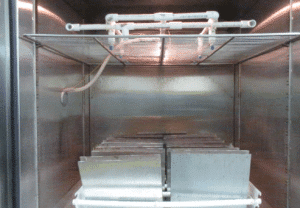SAE J2334
Cyclic Corrosion Exposure Testing
SAE J2334 testing is offered by Micom as part of its SAE testing and corrosion testing services . This standard describes a cyclic corrosion test which assesses the corrosive performance of a coating system, process, substrate or design. Also, this protocol is based on the guidelines of ASTM D2247 , ASTM D1735 and SAE J1563.
Laboratory cyclic corrosion test—use and factors to consider:
 SAE J2334 is a method which specifies the test conditions that are required to perform a cyclic corrosion test that replicates, on an accelerated basis, an outdoor exposure. Actually, this protocol relies on three periodic segments: the humid, the spray application and the dry stages. The wet and the dry part of the cycle are there to mimic the natural cyclic conditions while the role of the spray application is to introduce the corrosive solution that is composed of 0.5% of NaCl, 0.1% of CaCl2 and of 0.075% NaHCO3. The goal of this standard is to foresee the corrosive performance of the sample in his conditions of use. Indeed, through the periodical evaluation of the corrosion rate and of the scribe creepback values, it is possible to determine the actual performance of the material due to the fact that this method is a field correlated test. Hence, there is a relation which links the performance observed in the test conditions and what is experienced in the field.
SAE J2334 is a method which specifies the test conditions that are required to perform a cyclic corrosion test that replicates, on an accelerated basis, an outdoor exposure. Actually, this protocol relies on three periodic segments: the humid, the spray application and the dry stages. The wet and the dry part of the cycle are there to mimic the natural cyclic conditions while the role of the spray application is to introduce the corrosive solution that is composed of 0.5% of NaCl, 0.1% of CaCl2 and of 0.075% NaHCO3. The goal of this standard is to foresee the corrosive performance of the sample in his conditions of use. Indeed, through the periodical evaluation of the corrosion rate and of the scribe creepback values, it is possible to determine the actual performance of the material due to the fact that this method is a field correlated test. Hence, there is a relation which links the performance observed in the test conditions and what is experienced in the field.
The main factors that are in play when conducting this test protocol are: the temperature, the relative humidity and the length of each stage.
Typical Experimental parameters:
The number of samples required is one and the test conditions must be monitored by corrosion coupons of low-carbon cold-rolled steel sheets of 25.4 X 50.8 mm (coupons of other metals may be included as well). The properties of the coupon and of the specimens have to be assessed at a predetermined interval (typically a 20 cycles period is selected). More precisely, the mass loss has to be quantified for coupons while the corrosion rate and the scribe creepback values have to be evaluated for the samples. Lastly, the test is usually conducted for at least 60 cycles and table 1 lists the characteristics of each stage of the method.
Table I : Description of each stage method
| Parameters | Humid stage | Salt application stage | Dry Stage |
| Temperature | 50°C | Ambient conditions | 60°C |
| Relative humidity | 100% | n/a | 50% |
| Length of the stage | 6h | 15 mins | 17h and 45 min |
Other test methods related to SAE J2334:
For additional related test methods, please see; ASTM D1735
If you have any questions about the SAE J2334 test, we invite you to contact our material testing lab today. It will be our pleasure to answer your questions and help you with your custom material testing requirements.

